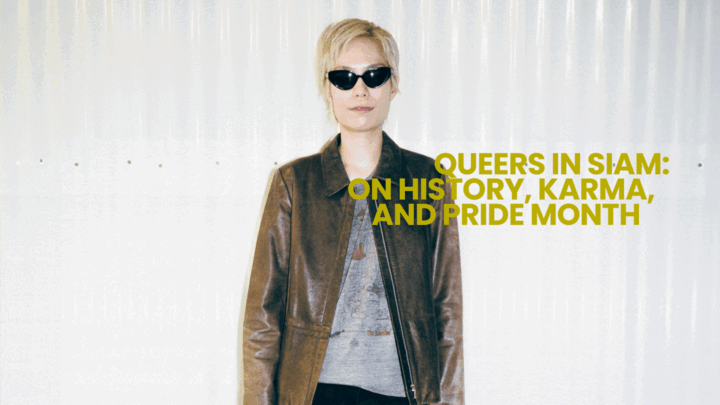Queers in Siam: On history, karma, and pride month
In an age when queerness keeps spelling itself in longer, ever-growing letters– so we may name ourselves in ways truer to who we’ve always been; in a time when love must be proven to be protected; in an hour when our bodies are still medicalized into compliance; in the very second that gender is bureaucratized into binary– what matters is whether our lived experiences can untangle themselves from the confines of gender’s prescribed form, and whether we can outrun the bureaucratic instinct to diagnose everything into a name, a form, a code.
Across the long arc of struggle for gender equality– from the Suffragette movement and Stonewall uprisings to the recent passage of marriage equality in Thailand– each moment reminds us: justice is never won overnight. It is fought for in the everyday. And it unfolds across battlegrounds both vast and intimate: in internet forums overrun by incels, in parliaments ruled by straight men, in beauty standards, in the meanings we attach to language, and in the violence of being watched in a public restroom.
We bring into view the ways gender has been shaped, inherited, and lived– not fixed truths, but frameworks we’ve been asked to inhabit. These ten stories do not seek grandeur, but speak to the quiet force of becoming: that gender cannot be reduced to flesh, form, or function; and that our resistance is not bound by time, nor our existence by celebration.
Before Rainbow Flags
Long before rainbow flags fluttered along Bangkok’s thoroughfares and through the arteries of Thailand’s provincial cities, we must begin elsewhere– nearly three centuries back, in an age when science was only beginning to fashion itself into the dominant language of truth in 18th-century Europe.
French philosopher Michel Foucault, a fierce critic of modern systems of power, argued that sexuality is not a natural truth waiting to be uncovered– but something constructed through institutional forces. In The History of Sexuality, Volume I: The Will to Knowledge (1976), he doesn’t offer a theory of gender identity. Instead, he examines how power operates: how repression, regulation, and knowledge production intersect to shape what is seen as ‘truth.’ Sexuality, for Foucault, becomes a lens– one that reveals how medicine, through sexology and psychoanalysis, grants institutions the authority to name, explain, and define. These systems didn’t merely study bodies; they made them into knowledge in ways that could be governed. They created the very categories by which people were seen, sorted, and disciplined– transforming lives into cases, and selves into subjects.
As the scientific method emerged as a dominant language of truth, its promises of neutrality, verifiability, and objectivity seeped into every branch of Western knowledge. In this context, sex became an object of study– dissected through organs, hormones, chromosomes, the brain, nervous system, and even musculature. At the same time, European societies celebrated sexual morality while obscuring sexuality in the public sphere. Sex education, then, took on the task of sorting bodies through biology and correcting what it deemed deviant. It was seen as a way to address disease, impotence, and behaviors pathologized under moral frameworks, shaped by enduring religious doctrine that cast pleasure divorced from reproduction as a sign of degeneration. Control of sexuality became a pervasive authority, operating from all fronts under the guise of ‘public hygiene,’ giving medical professionals the authority to decide who fell in line with ‘nature’– and who fell outside it.
Not only were bodies regulated through medicine and morality, but identity itself– gender and sexuality– became instruments of social order. In the modern European state, they were not just personal truths, but tools for classification, control, and containment.
By contrast, the boundaries of gender in East Asian cultures were often more fluid, with gender identity and sexual expression intertwining in ways that resisted binary classification. In Japanese monastic life, for instance, relationships between monks and beautiful young novices were not uncommon, reflecting a form of intimacy and gendered desire that didn’t map neatly onto Western categories of sexuality or identity. Similarly, in Chinese opera, male performers who portrayed female roles were not only artistically celebrated but also became objects of admiration and desire among the intellectual elite– particularly during the Qing dynasty, when ideals of masculinity embraced softness and beauty traditionally coded as feminine. In this context, a man who embodied a woman’s beauty was sometimes seen as the most complete expression of humanity.
In some indigenous communities, such as the Mbuti of Central Africa, where Western conceptual frameworks around homosexuality may not fully apply, intimacy and pleasure are not always framed in binary or reproductive terms. Anthropologist Colin Turnbull, in The Forest of People (1961), described how Mbuti individuals might dance alone in the forest, suggesting that their relationship to sensuality is deeply embedded in the natural world. While Turnbull’s work has been critiqued for its romanticization and projection of Western ideals, his account offers a glimpse into alternative understandings of bodily connection– ones not strictly tied to reproduction or binary notions of intimacy.
Gender, in many Asian cultural contexts, is not solely a matter of outward expression– it also holds spiritual dimensions. In spirit mediumship rituals across Southeast Asia, the medium occupies a role that bridges the human world and the spirit realm. Mediumship is often passed down through matrilineal bloodlines and creates space for those who are not men to assume roles within spiritual belief systems. Pu mia– a local term for gay or kathoey individuals in Lanna cultural traditions of Northern Thailand– have long moved through ritual with grace and devotion: dancing, arranging flowers, preparing bai sri offerings, and serving as ma khii– spirit mediums who connect the human world with the realm of spirits. Where ma khii stand between worlds, pu mia stand there often– more so than others. And in that presence, we catch a glimpse of something enduring– that gender, as it is held in ritual and shaped through relation, often moves in ways that do not align with the logics inherited from the West.
Even as each culture carries its own nuances, the world’s entanglement through global capitalism has served as a driving force in shaping gender norms– guiding social attitudes that draw firm boundaries between the roles, expectations, and behaviors of men and women. These divisions became especially visible during the Industrial Revolution, when shifts in labor began to reshape not only economies, but the intimate architecture of daily life. Amid these changes, gendered divisions became even more entrenched. Men were cast as breadwinners– those who left the home to earn a wage– while women remained inside, tasked with care, upkeep, and the invisible labor of domestic life. In Thai society, this dynamic is echoed in the familiar proverb: men are the front legs of the elephant; women are the back legs– an image that affirms hierarchy even in movement. These roles were not just normalized but institutionalized, with marriage upheld as the apex of heteronormative life. Those who fell outside this binary found themselves without a legible place in the system. This is reflected in the status of kathoey– often described as a “third gender” in Thai society– who, while not necessarily viewed with outright disdain, are still seen as neither man nor woman, and are left without a clearly recognized gender role to hold them.
Gender has been reduced to a question of biology– of hormones, testes, ovaries, and developmental psychology– stripped of the longings, pains, inspirations, and hopes that animate lived experience. This narrowing reflects the global reach of Western logics of gender, carried across continents through the twin forces of colonialism and modernization. Medical discourse continues to monopolize the truth of gender, eclipsing the felt realities of those whose lives exceed its clinical gaze. As postcolonial feminist scholar Gayatri Chakravorty Spivak has observed, women– and others whose genders fall outside dominant categories– are rendered voiceless in the Third World, caught in a double bind: silenced first by imperialist regimes of knowledge from the West, and again by the patriarchal traditionals at home. She writes urgently of how ways of knowing that fall outside Western rationalism are vanishing from collective understanding. What remains is a hollowing: experience, frustration, and feeling reduced to murmurs no one hears– voices of the silenced, struggling even to be uttered.
In light of this, we must ask: if the rainbow flag waving through Pride parades signals that the world has entered an era of gender equality, then what allowed inequality to take root in the first place? To what extent can we speak from personal experience and be truly heard in our own voice? And beyond that, can today’s queer community in Thailand truly claim to be inclusive and welcoming of all forms of difference, all ways of being?
To engage these questions more deeply, we invite you to explore ten stories– lives lived in a world where gender is not an abstract concept, but an ever-present force that moves through the intimate fabric of the everyday.
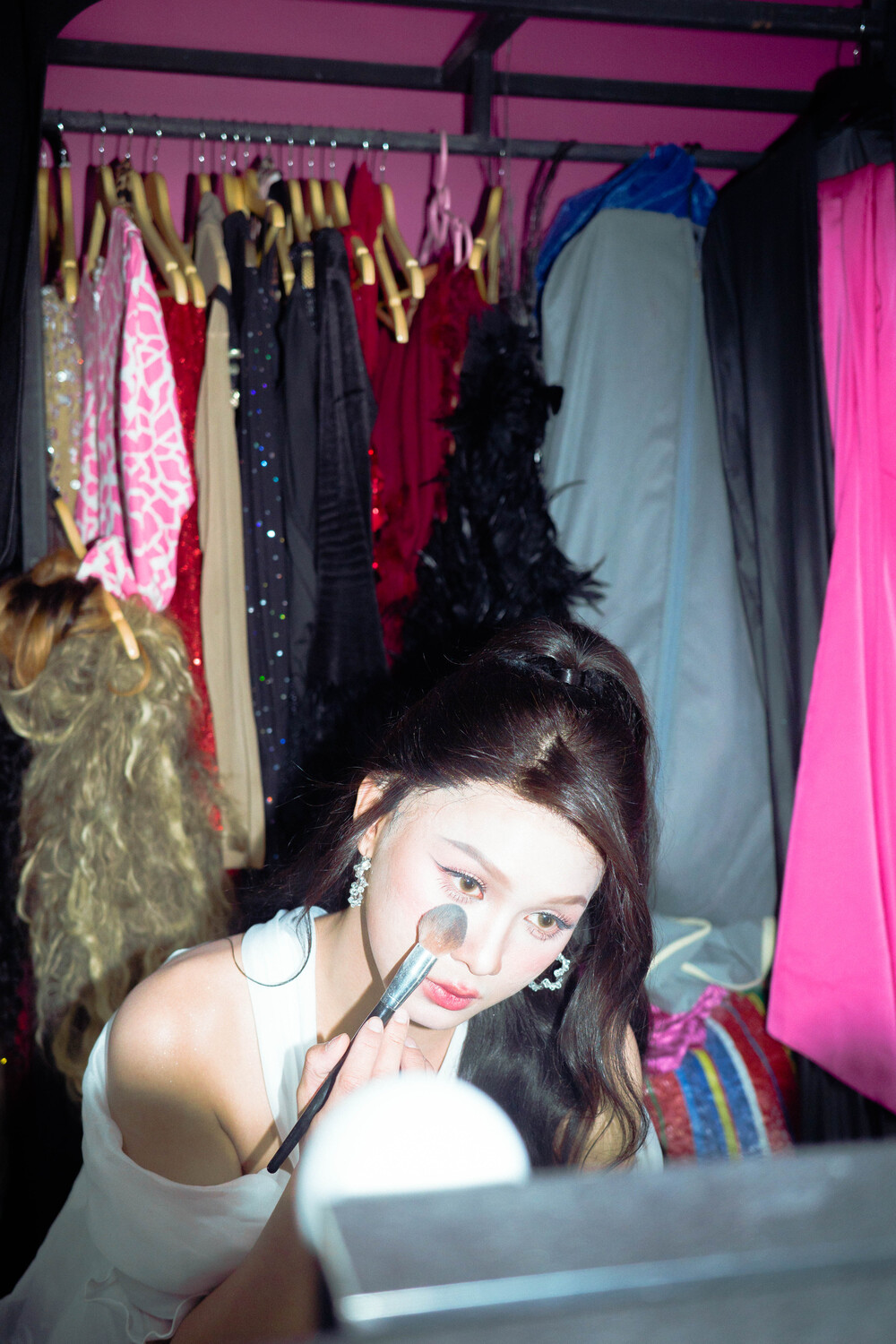
Alter Ego
“I was a child who was forbidden from showing any femininity, so I carried a deep sense of repression because of it. My parents didn’t find out until I was in university– when I started doing drag and was about to compete. Doing drag felt like a detonation that helped me loosen the knots I’d been holding inside. It became a source of happiness for me. Like I was finally able to go back, tend to, and reconnect with that child I used to be.”
“Doing drag is like creating an alter ego– another version of myself that lets me become who I’ve always imagined I could be. And crafting that alter ego until it reaches that point? It’s pure euphoria.”
“I like gay men. I don’t have a long-haired look, I’m not trans, and I don’t have an alter ego that presents as traditionally feminine. I don’t feel like I have to try to force anything. I just wake up and get to choose what I want to be that day– maybe I want to dress femme, wear a short wig or a long one. At the end of the day, gender is about expression. We all have the ability to show up as any gender we want. That’s the joy of dressing up.”
“I call myself queer, broadly speaking, because I’m still unsure– still figuring out my identity. I’m enjoying the exploration, the fluidity. Some days I feel like dressing femme, other days I want to just be gay. At the same time, it overlaps with my work, which sometimes requires me to present as a woman. It’s a spectrum– constantly shifting, never stopping.”
“How we view binaries is deeply personal. I’m of two mindsets– part of me wishes we could live in a world without them. But the truth is, the mainstream still runs on binaries, and society’s expectations are shaped by them. That divide is still embedded, deep down. And to gain acceptance in a capitalist world– to make a name, to earn a living— some form of binary still has to be navigated. Still, I believe the world we all long for is one where those binaires no longer hold power.”
GAWDLAND (pronounced God-land) is a 23 year old drag artist known for her dazzling, ultra-glam style– one of the most distinctive of her generation. She’s not just a drag performer, but also a TV personality, superstar, actor, influencer, TikToker, Instagram model, and certified hot girl of the internet. Many came to know her through the stage of Drag Race Thailand Season 3.
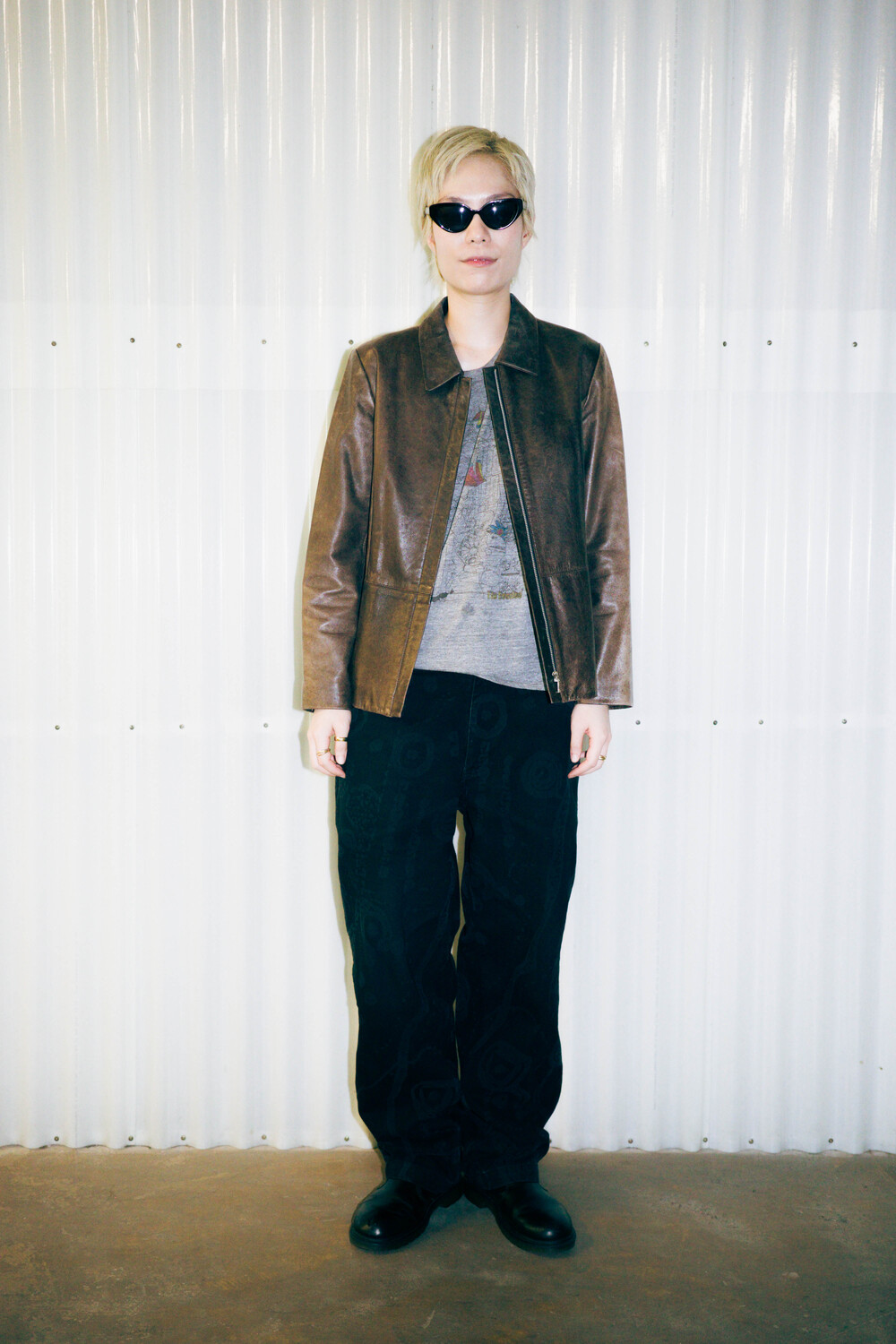
Boyhood
“I’m an only child and grew up in Bangkok. I didn’t have many friends as a kid. I remember only having friends around 4th grade, and they were mostly girls from school. But back in 1st or 2nd grade, I used to have guy friends who hung out near the shop where my mom worked. That was the first time I realized how great it must be to be a boy. When they went out to play, their moms didn’t come looking for them. But whenever I went to the arcade, down a nearby alley, or to places like Baiyoke Tower or Pata Mall, my mom would always come check on me– she was worried someone might try to trick me or lure me away. That made me feel like being a boy came with so much freedom. I wanted that.”
“Around the 6th grade, I started to feel attracted to girls. I saw an older girl in the 9th grade at school who seemed really cute. Her group of friends seemed really interesting– I wanted to talk to them. I started becoming interested in girls and tried talking to her. It was all very childlike– I just wanted to get to know her. I asked for her number and called her every day to sing love songs (laughs). I've loved singing since kindergarten. But I wasn't seriously trying to flirt or anything– I just wanted to talk to her.”
“When I started Mathayom 1 (Grade 7), I still had long hair because I had just transferred from a Christian school. I used to wear it long and even braided it sometimes. But by Mathayom 2 (Grade 8), because it was a co-ed school, I started cutting it short. That was when the word ‘tom’ (Thai term for tomboy) started showing up in my life. I started noticing older students with short hair being called tom. I wasn’t sure if that was something I wanted to be, but I went along with it and cut my hair. It actually felt really comfortable. And in a way, it felt like I was breaking the rules– just a little.”
“I’ve never had a conflict with myself, but other people have had conflict with me. Like back in Mathayom 1 (Grade 7), when I had long hair, some boys at school or older students would flirt with me. And some older girls didn’t like me– resented me. But when I cut my hair short, the boys who had liked me didn’t anymore, and the girls started liking me instead. No matter what I was, someone always had a problem with it– whether I had long hair or short. But that wasn’t important. After I cut my hair, it felt like some kind of path hard clearly opened up. So I went and confessed to an upperclassman and we ended up dating.”
“When I started secondary school, I told people my name was ‘Pat,’ which comes from my full name, ‘Sutthipat.’ ‘Pat’ was just easier to say, so I introduced myself that way. It became a habit and made communication easier. I didn’t really think too much about it.”
“Last year (2024), I decided to start using the name Mamiaw again because I was beginning a new chapter in my career– I debuted as a solo artist. I was thinking about what name to use as a solo artist, and after going back and forth, I thought, Why not Mamiaw? Just bringing that name back helped me reconnect with parts of myself from the past– who I was as a kind, how I grew up, through highschool, university, graduating, working. I think some things have changed along the way, and some things haven’t changed at all.”
“Mamiaw is probably about not overthinking. The Mamiaw I was as a kid didn’t think too much at all. If I wanted to do something, I just did it. That’s how I want to be now. As we grow up, we tend to overthink, worry about this and that. But I don’t want to stress about things that haven’t happened yet or things that have already passed. I just want to be present.”
“There was something I once talked about with Aom (Aom– Pattawee Thepkraival, director and Festival Director of H0M0HAUS). I asked why there was so much anger inside me. I didn’t know if I was the only one who communicated through every song I wrote– beneath the sadness, there was always anger. And Aom told me that it’s normal. Aom felt the same way too. Because the image of being queer of LGBT isn’t accepted in society, it’s like, just sitting there and breathing is already wrong. There’s always something that happens. It’s like we have to suppress a part of ourselves, and inside, all that’s left is this feeling of, ‘If I were a “normal” person, maybe I wouldn’t have to feel like this.’ There was someone I liked when I was a kid and he liked me too. But he couldn’t accept that he liked someone who was tom.”
MAMIO, or Mamiaw– Suttiphat Suttiwanit, is a singer, songwriter, and solo artist who has moved on from their former role as the lead vocalist of Zweed’n Roll.
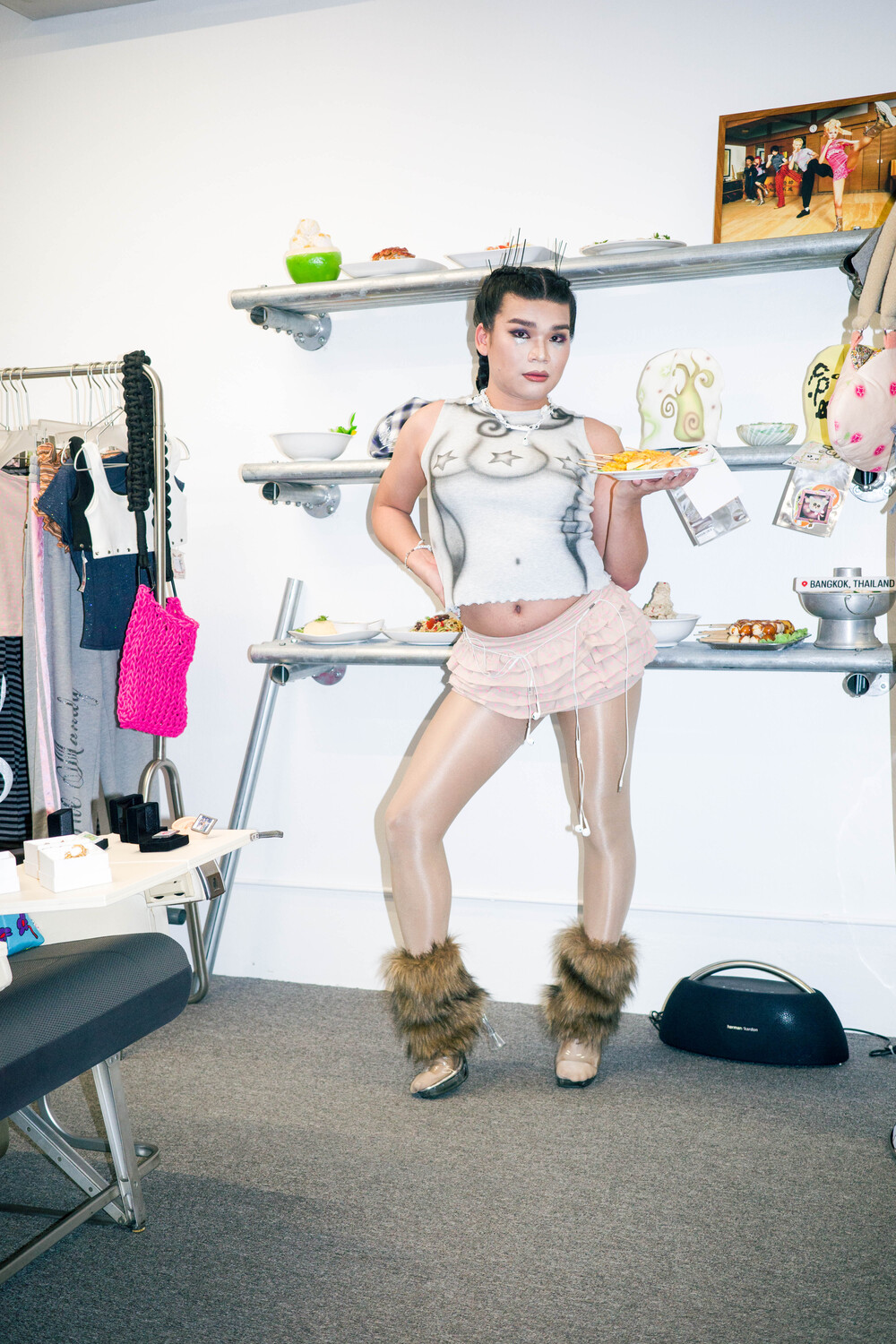
Living Experiment
“Back when I identified as gay, I was cool and handsome like a guy– everyone was hitting on me. I even thought about doing something drastic, ‘Maybe I should dress as a woman just to avoid the military draft,’ because I was too handsome. I felt like, ‘If I were to ask for a medical certificate to verify my gender, there’s no way I’d get it.’ I hadn’t even gone to apply yet, I’d only asked hypothetically and they said, ‘You’d have to get breast implants.’ They just didn’t get it. So I panicked. And since I hadn’t moved to Bangkok yet, I didn’t know much– my world hadn’t opened up. I kept deferring the draft again and again, and once I started becoming well-known and had some money, I decided to get breast implants.”
“In the end, it really just came down to not wanting to be drafted. But it wasn’t about forcing myself to be anything. I could live in any body– I’ve loved every version of myself. And in each version, there’s always been queerness. At that moment, in that body, I felt joy. I wasn’t forcing it. I wasn’t depressed or spiraling. Though it was kind of brutal– like a science experience in genetic modification (laughs). But I enjoyed it. And if in the future I’m able to add some metal to my arms? I’d go for it. Fierce.”
“If I had to define what being queer means to me, I’d probably have to come up with something new entirely, ‘My gender is Roblox’ (laughs). I feel like I’m somewhere on the asexual spectrum too, because I don’t really crave what I call, ‘PlayGone - PornGay.’ I don't have a strong desire to sleep with other people. I prefer playful conversation, getting close first, and then taking it further. One-night stands aren’t my thing– but I’m not against them (laughs). I could be down, but I’ve never had one before.”
“I feel like ‘queer’ is about diversity. I feel like that’s what I am. I’ve never defined myself as, ‘I’m gay’ or ‘I’m bisexual’– I just go with the flow. It’s all good. As a kid, I liked girls. As I grew up, I started liking daddy boys (Thai queer slang for men who are both suave and youthful), liking men, and gay guys. Even now, I feel like there’s still that 10% that I sometimes like women, sometimes I like handsome toms, sometimes it’s men, or bad boys. I even like rappers.”
“I never really had a phase of feeling lost about my sexuality. Maybe I had good immunity. I mean, society wasn’t exactly great– I didn’t grow up rich, and my school life was just ordinary. But I stayed in my own world. It was like I had a bubble around me. And when people entered that bubble, it was like they’d stepped into my world– my own fabulous little village where I reigned supreme. I liked sending out positive energy to everyone. And if I ever felt sad, I wouldn’t let that energy spill over. I’d just share how I was feeling– sometimes I’d spiral, and sometimes I’d bounce back.”
“You can wear whatever you want, as long as it doesn’t hurt anyone else. That idea applies across the board. And exploring your gender or sexuality isn’t wrong either. I’ve experimented with my own body. Even if other people make negative comments, if you’re okay with it, then that’s enough. We don’t have to let other people’s words get to us, and we don’t need to assume people are always talking about us in a bad way. Honestly, no one is paying that much attention. Once you realize that, life gets easier. Of course, you still have to live within some basic social norms– like, don’t go around shooting people or screaming at strangers. That’s it. ‘I’m just living that life,’ like Addison Rae said. Period.”
James, also known as babyjolystar, is a TikToker with nearly 3 million followers who recently released tracks like ‘Hedrabee’, ‘Poussé’, ‘Trew Online,’ building on the massive success of ‘Strawberry Morakot.’
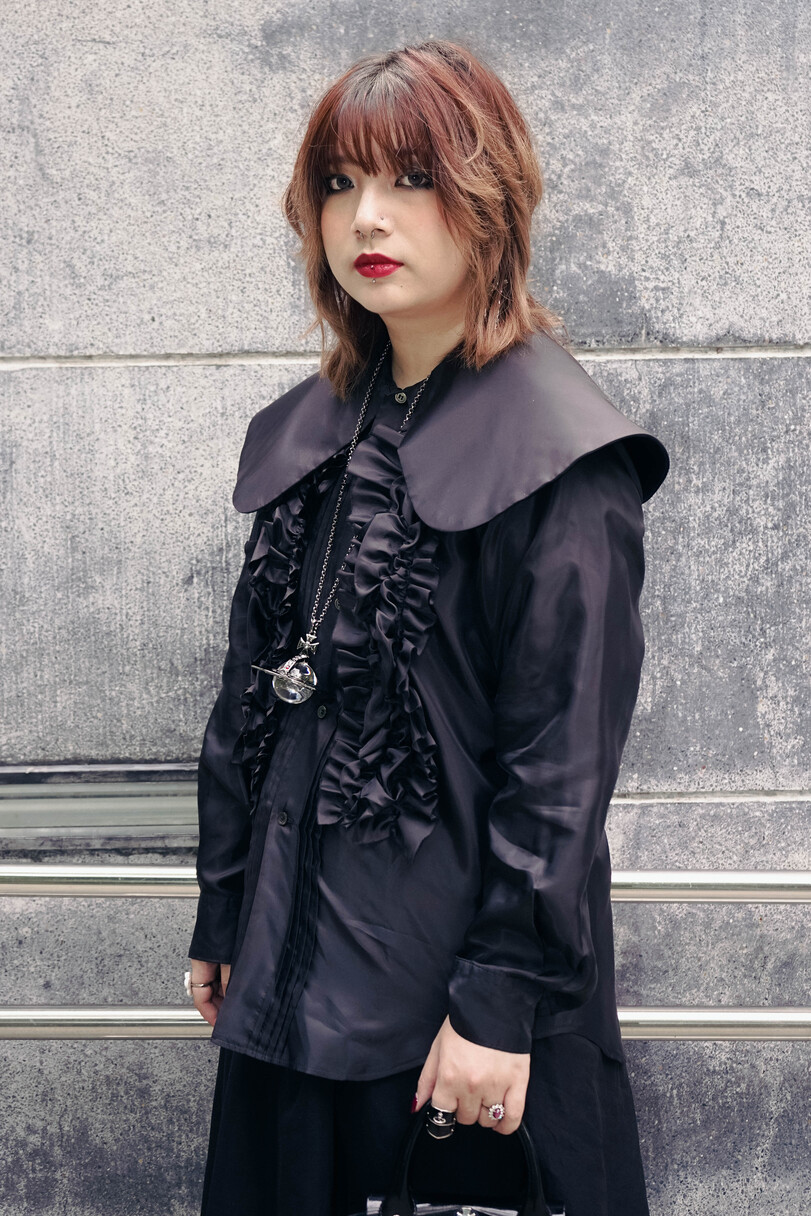
Spark Joy
“I went to an all-girls school from kindergarten (K2) through the ninth grade. Toward the end of elementary school, I realized I liked girls– I even had a girlfriend. When I transferred in junior high, I wanted to try changing my look to be more masculine. I got my hair cropped short– shorter than the school rules allowed– and pierced my ears multiple times. I was trying to express myself. At the time, I was also really into cosplay and fascinated by Japanese culture.”
“Back in lower secondary school (Mathayom 1-3), I was really popular. Upperclassmen liked me, classmates like me, even juniors made a fan page for me. I was super cool at the time– a handsome tom at school– especially because I was on the student council and had my hair cut shorter than the rules allowed. That only made the fans love me more. There was a time when I didn’t dare wear a bra and walked with a hunched back, afraid my breasts were too big– it didn’t look cool. That stuck with me. During Club Week, I was in the anime club and had to perform in a show. So I sang Koisuru Fortune Cookie by AKB48 in the middle of the school courtyard. I had to wear a mini skirt and makeup. I felt confident then– dancing and singing. But after that day, people started looking at me differently because I didn’t look tom anymore. An upperclassman later told me that the girl who had been flirting with me was heartbroken– she cried– because I came off too feminine. I started to feel confused about how I should express myself. Should I present as fully masc? Or was it still okay to cosplay in cute outfits? After that, all the way through upper secondary school, I stopped dressing up altogether– just wore t-shirts and jeans. But when I transferred to a co-ed school in high school, I got more exposure to different genders. And even more so in university. That’s when I started dressing up again. I think it was in university when I first started to think of myself as beautiful.”
“I saw a Discord conversation on Twitter where someone said, ‘Some people don’t seem truly bi because they've only ever dated men and never women.’ But I don’t think that matters. I believe I can spark joy with anyone– it can happen at any time. Right now, I’m in a relationship with a man, but that doesn’t mean I chose to be with him because he’s a man. I’m still open to all genders.”
“The first time I publicly cosplayed at my all-girls school was like the first door opening for me to start questioning: Do we really have to dress according to society’s ‘standards’ for how different genders should look? Why is that doing something that made me happy led to backlash? It took me years before I could finally feel brave enough to dress the way I truly wanted to.”
Amy (@falloutamy) graduated with a degree in Communication Arts about three years ago. She’s currently working as a graphic designer at a company and identifies as pansexual.
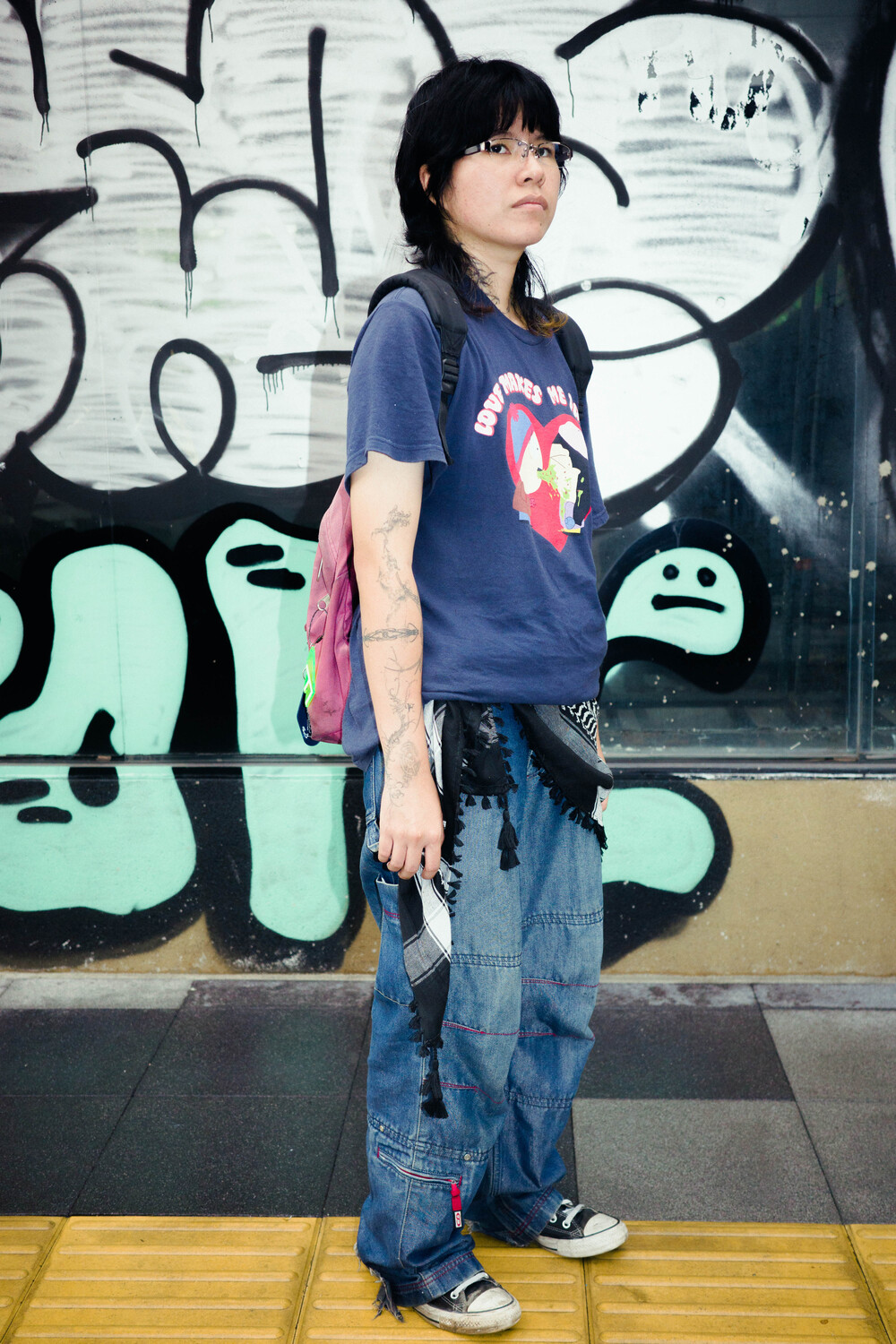
It Doesn’t Exist– It’s Nonsense
“I didn't like my body starting from junior high, when my hormones began shifting into adolescence. I started to grow breasts, I got my period. By the time I was in high school, I began having cramps and started feeling like menstruation was something that belonged to women– and I had to try to distance my body from being seen as female as much as possible. But I still had my period. I still had breasts– though not very big. I couldn't even look at my own genitals. I’d rush through showers just to get them over with. I hate my body. I remember looking at myself in the mirror and crying. That was a time of deep suffering, having to live through what society told me a woman was supposed to be. But after I learned about the concept of being non-binary, I began to forgive my body more. Especially once I started working around menstruation and period-related projects– it helped me forgive myself even more. There are still times when I spiral and think, ‘Why does my body have to be like this?’ The feelings come and go in waves. Lately, I’ve been kinder to myself. I feel better in my body. If you ask me whether I want breasts or a period? No, I don’t. Like I said, not everyone has access to gender-affirming surgeries, and not everyone wants them. We should stop policing each other’s identities.”
“I’ve felt like I was a little boy for as long as I can remember. There’s a photo of my peeing standing up because I wanted to do it like my older brother. I had to stop because it was way too messy– every time I peed, I’d have to take a shower afterwards. Still, everyone around me, especially the other kids, saw me as a girl. My male relatives wouldn’t wrestle with me the way they would with other boys, because they saw me as a girl. But at the same time, I sometimes felt like a little girl too. It’s not like I was resisting that part of me.”
“In elementary school, kids started teasing me for being tom. I really hated that word. I saw myself as a little boy– not tom. When I got close to guy friends, other kids would tease us, saying we were dating. So I ended up having to hang out with the girls instead. And there was a part of me that was feminine, too. Being part of the girls’ group helped me survive in a school system that was so binary.”
“I liked girls all the way until the end of 9th grade. Then, heading into 10th, I started developing feelings for guys and others too. I thought they were kind of cute. But I felt terrible about it. I’d think, ‘Why the hell do I like guys?’ and ‘I’m supposed to only like girls– because I’m tom.’ I carried that pressure around until high school, when I transferred to a co-ed school.”
“I really struggled with my hair too. I didn’t like keeping it long– I wanted to crop it short and make it look cool. But if I cut it just to the ears, it looked awful. And when I did go for a short haircut, I’d get written up for it. Luckily, in the 11th and 12th grade, the teachers were more chill and understood me. At the time, I was still struggling with being tom while also having feelings for guys. But once I got to university, the environment was way more open. There were people who were bisexual, there were gay people– everyone was just being themselves. That’s when I came across the word ‘Non-Binary’ on Facebook, and it just felt so right.”
“After that, I got to know a non-binary person who helped me understand the distinction between gender expression, gender identity, and sexual orientation. I began to understand myself more. Like, if you identify as tom, you can like only women– or you can be attracted to all genders. That helped me realize I was a non-binary bisexual person. Around the time the political climate was really tense. I joined protests and started speaking out about gender in politics– because to me, they’re intertwined. I started getting involved in activism from my first year of university, speaking out about these issues. I also got involved with Non-Binary Thailand back then. A lot of the organizing at the time happened online through debates, but there were some public rallies too.”
“In my first year of university, I felt like the term ‘trigender’ described me best– feminine, masculine, and neutral. Some days I’d wake up wanting to dress in a feminine way, so I would. Other days I’d feel more masculine, so I’d go with that. As I got closer to graduating, I began to feel more like I was trans-masculine– that there was more masculinity than femininity in me. Right now, I’m not really comfortable with femininity. But who knows? Maybe it’s just the cycle of life. In another five years, I might want to embrace some femininity again. For now, I feel comfortable identifying as a trans-masc non-binary.”
Two years ago, Bew (@yabeautdi2) presented ‘Secret Body’, an acclaimed art exhibition exploring the body beyond the constraints of the male gaze. Today, Biu is an artist, tattooist, and activist who identifies as non-binary and seeks to express their identity through art.
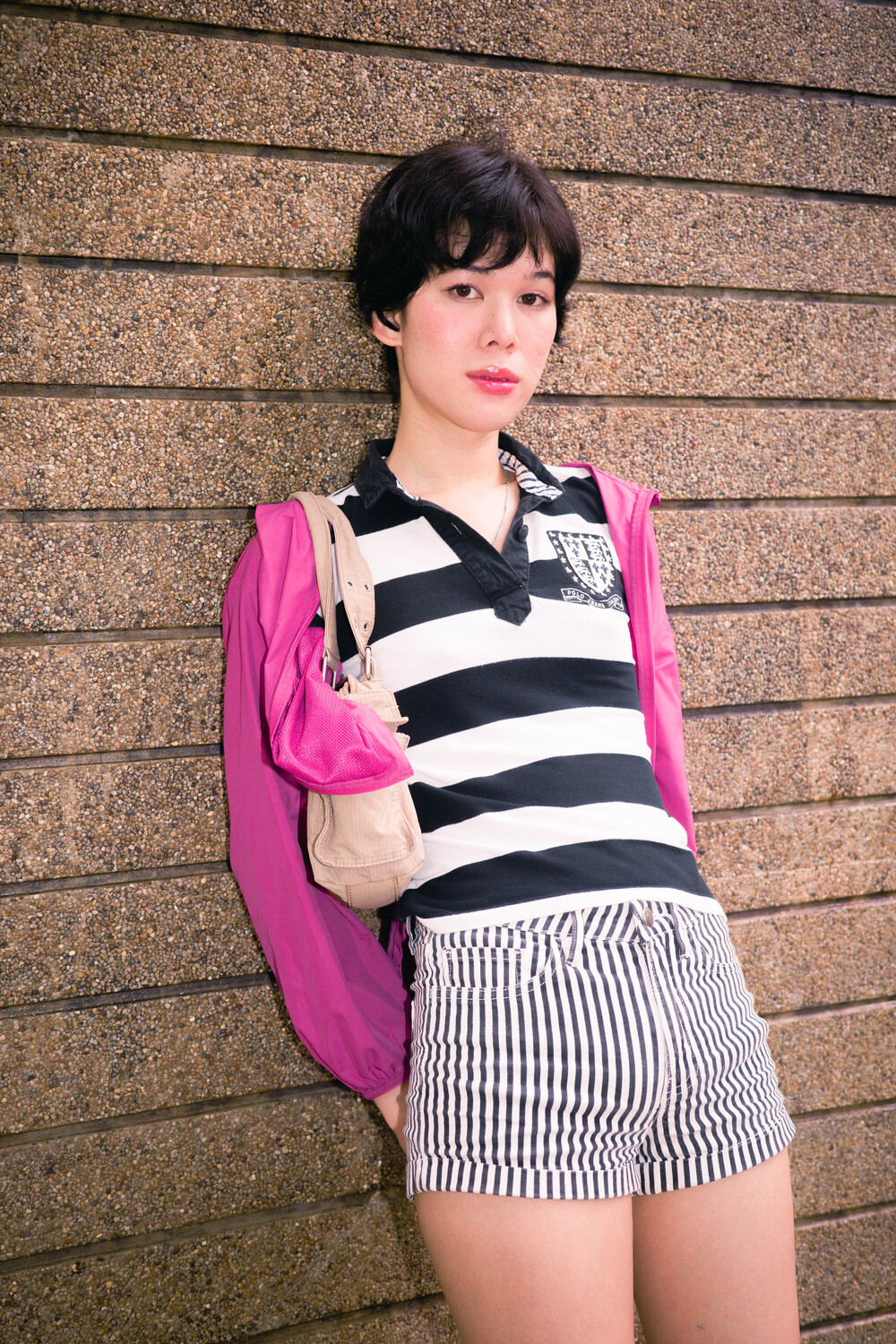
A Glitch in the System
“I’m trans because I’ve transitioned, but when it comes to gender, I feel like I’m anything but a man. The moment I wasn’t in a male body anymore, I became so much happier– my life got so much better.”
“I had a relative who sexually assaulted me when I was younger. Because of that, I ended up having experiences with men from a young age. At the time, I didn’t think much of it. He kept having me do things with him. He once asked me whether I was a girl or a boy, and then said, ‘Don’t be a girl. Don’t you dare be a girl.’ He was about six or seven years older than me and very much an alpha type. His dadd– my uncle– was extremely alpha too. I think that might be part of why I’ve spent my whole life suppressing the femininity that’s always been inside me.”
“By the fourth grade, I realized: I like boys. I like penises. I’ve always been gay. But the thing is, I ended up transitioning because I joined the military. In that environment, people say kathoey as women– as angels, as older sisters. And I felt like I was a woman. My life just didn’t feel like that of a typical man in the army. After I got discharged, I was ordained as a monk, which is an extremely male-centered environment. About two weeks into monkhood, I thought, ‘Oh gosh, maybe I’m not a man.’ I rushed to disrobe. On the very first day I left monkhood, I went straight into transitioning. I had no eyebrows, no hair.”
“When I had been in the process of transitioning for a year and went in for a hormone check-up, the staff member said, “You probably don’t want to be in-between, right?’ And I didn’t really know– ‘Maybe I do want to be in-between.’ B because the standard for Thai kathoey is that you have to be a woman. But, like, some of the women around me don’t have breasts, you know? Real women aren’t dolls. Most people expect that if you’re trans, you have to match the binary, and that’s exhausting. That said, I do want breasts now– because wearing a bra feels euphoric. I’ve liked boobs ever since I was a kid.”
“When I think about my life as a trans person, I feel like it’s mostly been full of good things. The only issue is the cost of hormones– because they’re not cheap. In European countries, they have healthcare that provides hormones for free, even though the transphobia there can be more intense. In Thailand, being trans is more livable, but there’s no healthcare support. Another thing is that I can’t smoke– there’s a risk of blood clots. I’ve only just started cutting back in the last two weeks (laughs).”
“I think trans identity in Thailand is heavily tied to the beauty industry. I once talked to a friend in France and over there, the queer scene tends to resist the system. But in Thailand, there’s more of a tendency to conform, like with beauty pageants. Many trans people don't understand why I don’t want to try harder to be more ‘womanly.’ I just don't want to fall in line. The truth is, women don’t need to have breasts, and she doesn’t need a man to define her. In Thailand, this kind of thinking is so deeply oppressive, it’s depressing.”
“The reason I feel like I don’t belong to any one gender might be because I believe that maybe, in this lifetime, I was meant to be kathoey. In other lifetimes, maybe that isn’t the case. I used to wonder– I’d sit and read about the Abrahamic prophets and think, ‘What if it is a sin?” because I’ve transitioned. The gender binary system says that there are only two sexes, but we’ve crossed that line. We’re a glitch in the system. But then I thought, no– because I’m so happy. Even if I am a glitch, maybe I’m just not a normal human being. Maybe it’s because we’re living in a posthuman era. People can transition now, after all.”
“Right now, I’m happy. Wearing beautiful clothes is so much fun– and by ‘beautiful,’ I don’t just mean feminine. It’s anything unusual, anything that men say you shouldn’t wear. That’s where the fun is. It’s not just about femininity; it’s about creativity too. Being myself doesn’t mean being a woman– it means having the freedom to express myself authentically. I’m not afraid anymore. I don’t have to keep secrets from my family. I get to fully be myself. And now that I’m kathoey, I even have work. If I were still gay, I’d probably just be out there hooking up all the time.”
“Not long ago, when I realized I wanted to get breast implants, it felt liberating– because when I was younger, I swore I’d never do it. Also, during my first year of transitioning. I cried a lot. And I was so happy that I could cry. I became more sensitive, and I was happy about that sensitivity.”
Garheep (@garheep) is a trans model and student studying sociology and anthropology.
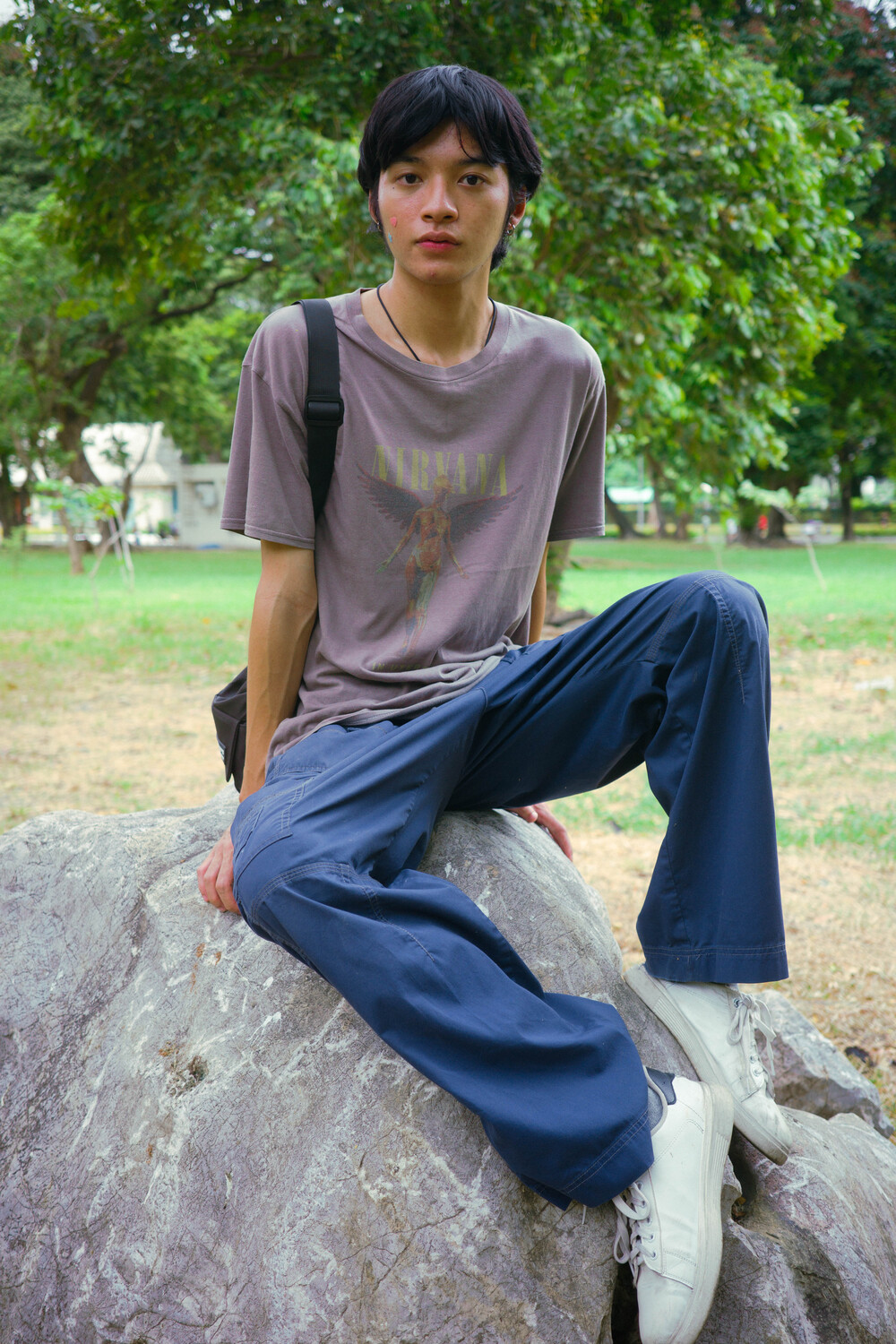
Non-duality, the Absence of Self, and Karma
“I’m a gay man. When I was a kid, I liked girls– I even had a crush on a girl in kindergarten. I kissed her on the cheek and she punched me. It was kind of funny (laughs). Later on, I discovered yaoi (Japanese male-male romance manga), but I still told myself, ‘I’m not gay or anything.’ But I kept reading it. By the end of elementary school, I started realizing I liked boys. By 7th grade, I started dating a guy. Every now and then, I’d still like girls. I had a crush on a girl once in university– she was a lesbian. She knew, and it seemed like she might have liked me too. But for the most part, I like men more. Calling me gay is probably the easiest way to explain it. I have a very specific type when it comes to women, and most of them are sapphic or cool, stylish lesbians.”
“I don’t really know much about the gay scene in Thailand because I’ve never really been part of it (pause). In terms of gender, there’s this sense of wanting to and expecting to conform, right? There’s a beauty standard within the gay community too. But I haven;t observed it all that closely, because I’ve never really been in gay circles. I don’t have many gay friends– most of my friends are trans or non-binary, which is its own subculture entirely.”
“I once had a conversation with a friend about the queer scene. The word ‘queer’ is a Western term that originally had negative connotations, and its meaning has been passed around and reshaped in the West. But when it enters the Thai context, it shifts again– it carries even more ambiguity.”
“In the Thai context, terms like gay, kathoey, or tut (a colloquial term used for effeminate gay men) are quite blurred. For people who study gender extensively, especially those grounded in Western frameworks, those frameworks ultimately can’t be fully applied to Thai society. Thai society hasn’t undergone the same kind of sexual evolution as the West. It’s not just about gender studies; you also have to study Asian studies, specifically Southeast Asian contexts.”
“Maybe it’s just karma– not in a good or bad sense, but whether you like men or women is just residual karma that we’re here to carry. That’s all it is. In the end, we just have to live in the present. We’re only bodies. Gender is just a thin concept that we try to grasp, something we try to hold on to. In one sense, it’s good to have names and definitions. But on the other hand, when we cling to names, we end up treating them as the core of our identity. Maybe we were born just to prepare to die. Don't overanalyze or try to find ultimate meaning. Studying this stuff is still good– it’s part of the evolution of human knowledge. But maybe it’s because I studied philosophy,.. and in the end, philosophy doesn’t actually give you answers. No one really knows. The only one who truly knows is the Buddha, right? (laughs)”
“If everything is anattā (non-self), then there can’t really be right or wrong– things just unfold as they are. True liberation doesn’t come from doing good or doing bad; it’s about going beyond both. You have to transcend duality– what’s called advilakkhana (non-duality). That’s really hard. People say, in the end, anattā is attā (self), in a way– if you expand the self so far that there’s no ‘you’ left, then that’s anattā too. Trippy, right? (laughs)”
Euro recently graduated with a degree in philosophy. He now works at a private company and runs sapphostirical, a shitpost page dedicated to chaotic queer thirst voiced through the lens of today’s youth.
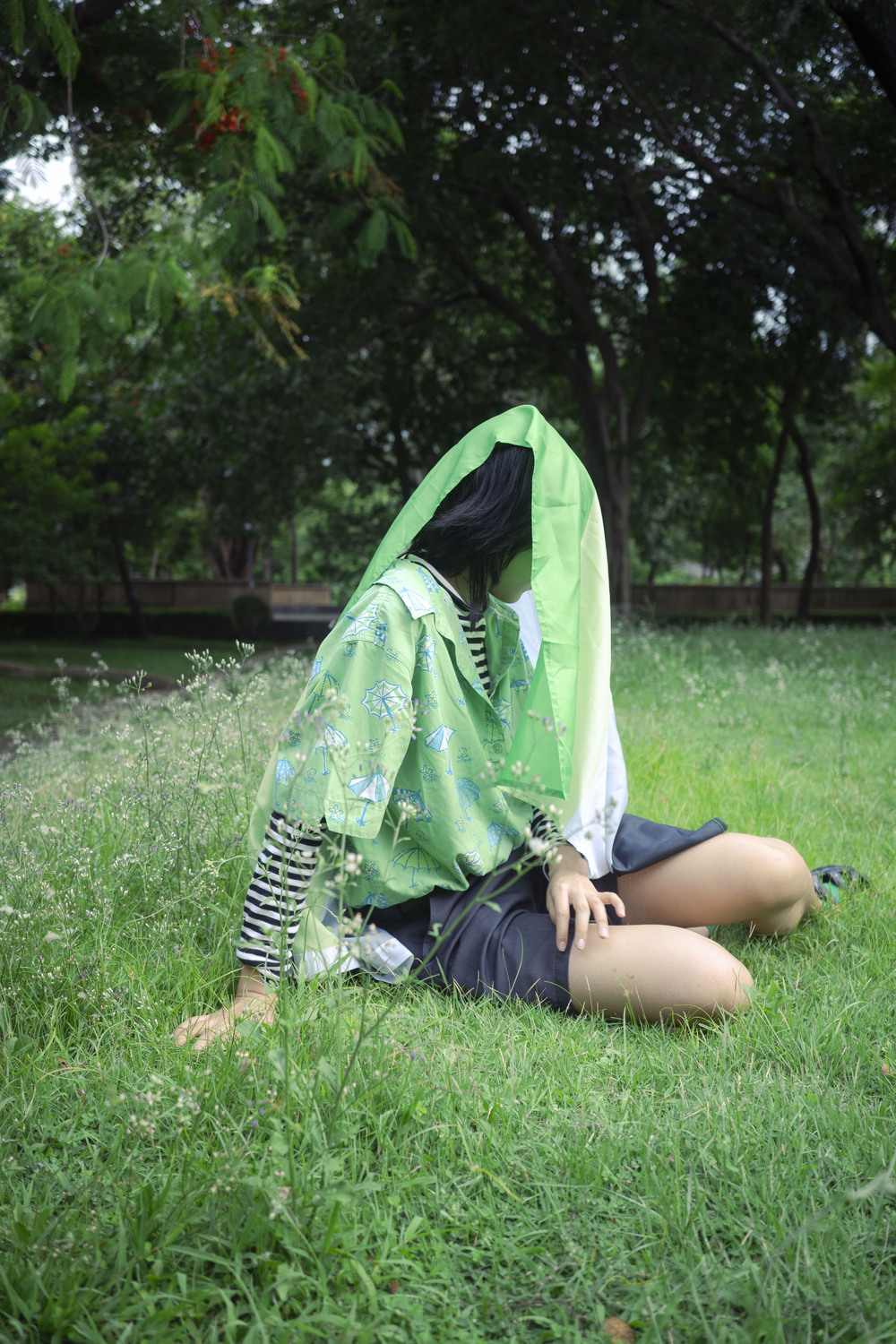
Retrospective
“I identify as aromantic asexual. I first learned the word ‘asexual’ back in middle school, after hearing a friend use it, but I wasn’t sure when it started to apply to me. It was like I knew the word, and then after a while, I started using it naturally. As for aromantic, I only started using that term around age 17 or 18, sometime in high school. I had a crush on someone and started reflecting on my feelings– what kind of feeling was that exactly? Then I came across the term ‘aromantic’ and thought, maybe that fits me. Because when I like someone, I don’t really distinguish what kind of ‘like’ it is. Most of the time, I just want to be close to them, get to know them better, and have them in my life.”
“At the same time, I often find myself questioning things that are taken for granted in society. Like, why do TV dramas always have to be about romance? Why are there so many love songs? Why does everyone act like being single or living alone is such a sad thing? And why is romantic love treated like the ultimate goal in life– like you have to get married, have kids, and live happily ever after as a family? I started to feel like, huh, that’s odd. I never really questioned it before, not until I had a crush on someone and ended up coming to terms with the fact that what I felt was probably this thing called ‘aromantic.’”
“In the end, it comes back to the question of how someone defines the kinds of relationships or feelings they experience. For me, that definition doesn’t include the word ‘romantic’– or anything like it. But that doesn’t mean someone who’s aromantic can’t have a partner. They can– it just depends on what they agree on.”
“The question is– why do people see romantic partners as more meaningful than having close friends? Whether you’re aromantic or not, there are so many ways to connect with people. Take platonic relationships, for example– they’re non-sexual, non-romantic, but still really special. It’s a way of queering relationships, of existing outside the usual boxes of ‘just friends’ or ‘romantic partners.’ Add honestly, you can have a partner and a queer platonic relationship too– why not?”
“As someone who runs a page and has a platform, I feel a responsibility to tell people that it’s not necessary to use all these labels. They’re so specific that it’s impossible to remember them all. Like I’ve said before, there are people who only feel sexual attraction to fictional characters, or who have a crush on someone and lose all attraction once that person likes them back. There are so many different kinds of people and each person’s experience is incredibly nuanced– and that’s the power and the limitation of language.”
“Having a label or a word gives you more power than having to explain with a whole sentence like, ‘I like people, but in this specific way.’ Saying ‘I’m straight,’ or ‘I’m a man,’ or ‘I’m a woman’– people get it immediately. That’s why having words matters. But sometimes it can feel like things are getting overly specific, to the point where it seems like some people don’t touch grass. Still, that doesn’t mean that everyone has to understand, or that we should force people to.”
“For me, the act of defining ourselves is retrospective– it’s about using words to make sense of our past experiences. That means whatever word feels right in the moment is valid. It’s not like I’ve never felt that way before; I’m using this word because I’ve felt it, and that can change. I think it’s tied to society too. In Thailand, most of the labels we know are the ones other people have assigned to us, like, ‘Are you kathoey?’ Are you tom?’ So we get stuck in this mindset that these words are something others have to give to us, that we don’t have the right to choose them ourselves. But when it comes to gender, it’s really about self-determination. We have the right to choose the words we want to use and the names we want to go by.”
“It’s hard to say whether defining yourself is important or not. For those who understand, they’ll see that it is important– in the sense that it helps people identify themselves, come together, and realize that they exist, that there are others who share similar experiences. But at the same time, it’s not important. On a personal level, you don’t need to define yourself. You don’t have to label yourself at all. It’s hard to talk about sometimes, because once society receives a message, it can only take in so much– like ‘LGBTQ+,’ where the letters become something people have to memorize, and sometimes it turns into a way for people to police each other within the community.”
“In the end, I’ve come to feel that my page isn’t just for people in the community. A lot of what I post is about deconstructing the norms that exist in society, like values around love and relationships, and those don’t just hurt people who are AroAce. They hurt everyone.”
Hed Kiew (Green Mushroom) is one of the admins of the page AroAce-clusionist: Aromantic & Asexual Exist and identifies as AroAce.
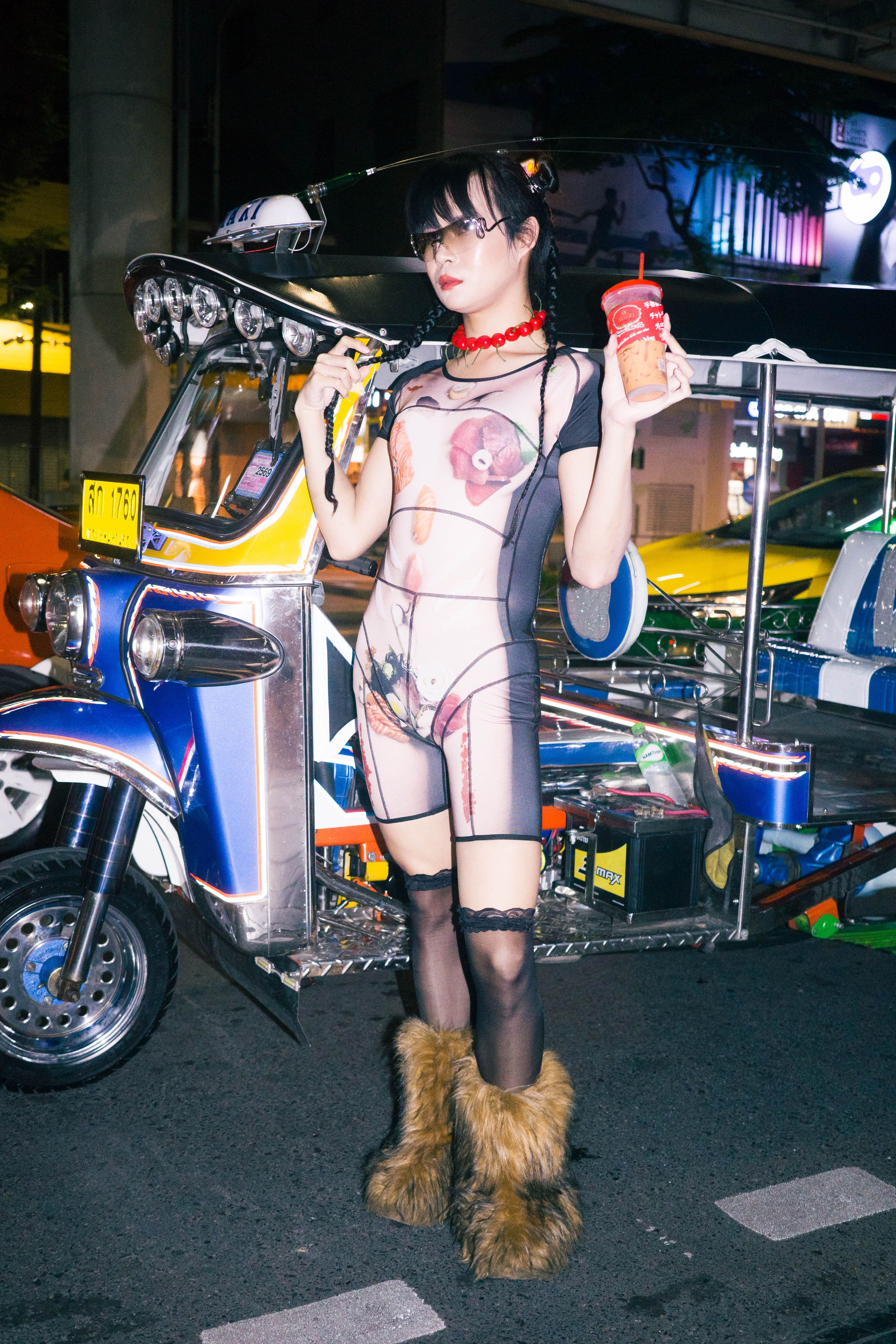
Beautiful Things
“I didn’t know from a young age. At first, I just wanted to dress up– I didn’t think I had to be a man or a woman. But if you ask whether I liked both men and women, I’d say I liked men. I liked dressing up. Some days I felt like being a woman, some days a man. I could wear a corset without having to say, ‘Today I’m female,’ or feel the need to get breast implants to transition.”
“I don’t label myself as anything. Some people might define me as kathoey, or call me gay or mae (Thai for ‘mother’) depending on the day– based on how I dress or the image I present. I feel like it’s more of a drag queen vibe.”
“I feel like, ‘I can be anything.’ If people see me as kathoey, that’s fine. If they see me as something beautiful, that’s enough. They can call me a man, a woman, kathoey, gay– whatever. I don’t feel alienated. I’ve never felt the need to fully transition. I mean, if I dress femininely, I’ll wear fake breasts or present in a way that feels as trans as possible, to look like a woman. But some days I just dress like a regular guy. It depends on the vibe– kind of unisex. Or some days I’m a man, but I dress extremely femme.”
“When I present myself this way, of course there are going to be people who like it– and some who don’t. But I choose to hold on to the good things. If someone doesn’t like it, I just let them be. Being myself, being my own person, is the best thing I can be.”
“Some people in Thailand still think that dressing femininely means you’re a tut or kathoey. Some don’t even realize that other genders exist. They only care whether someone is male or female– strictly within a binary. Some can’t even accept the idea of a third gender.”
“(In gay communities) there are tops who are very masculine, or gays who are super macho, and then there are the divas– the ‘mothers’– who don’t necessarily want to dress in women’s clothing but still have that queen energy. Some are a mix of both. Basically, gender is very fluid in my view. Sometimes even straight men want to try things with kathoey. It’s all very fluid, darling. I just want society to be more open. I want more people to feel free to be themselves, without having to stay inside someone else’s boxes or ideals.”
Prem (@pprempp) is a 27 year old freelance stylist from Nakhon Phanom, currently living in Bangkok. She recently underwent unisex cosmetic surgery to soften her physical features, aligning with her fluid fashion style that blends both masculine and feminine elements.
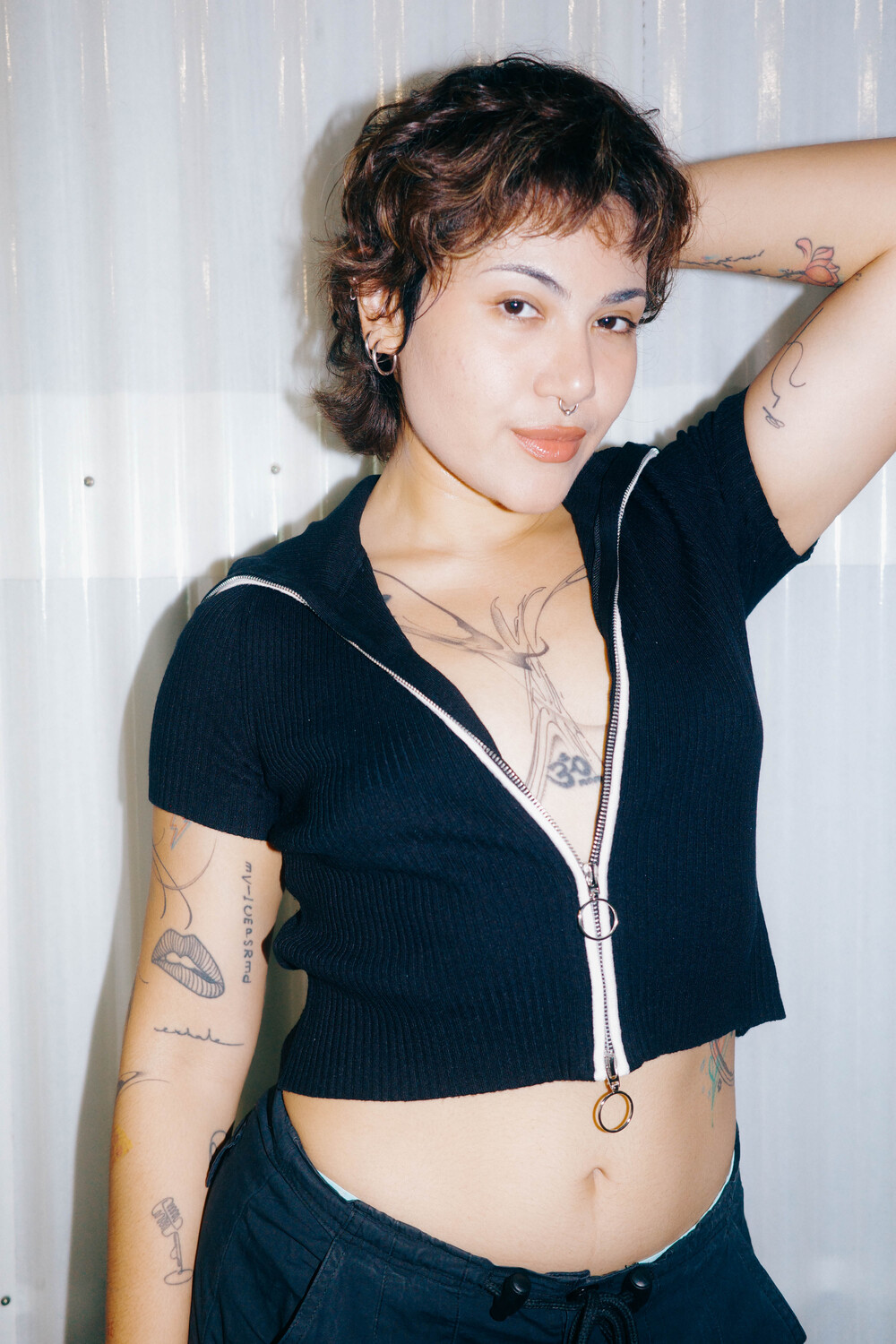
Self Love
“I realized I liked girls back in elementary school. At first, I felt like something was off– my friends were all talking about boys, but I wasn’t into it. I just wanted to be close to my female best friends. When that feeling became more intense than what others seemed to feel, I started realizing something was different. I’d get butterflies in my stomach– it wasn't like how my other friends felt. That was the first time I sensed that I might be different. But I wasn’t scared or ashamed. It was that fluttery feeling you get when you like someone. It made me feel excited more than anything else.”
“I really started to understand my feelings when I fell for a girl who was a close friend. We were so close that her mom wasn’t okay with it. I was told I was a bad influence and was forbidden from seeing her. We were forced to be separated. That was when I realized that what I was feeling might not be okay, that it might be seen as abnormal. I started to understand that the feelings I had for other girls might be considered taboo, or that this kind of love wouldn’t come easily.”
“I was really young then, only in 6th grade. I felt sad, lonely, and confused, wondering what I had done wrong. Why were we being treated like it wasn’t okay by the adults or people around us? I started to ask myself: why am I different? The feelings of love and affection I had were just like the ones my friends had for boys– exactly the same. So why was mine treated like something forbidden?”
“How did I get through it? I’d say I was a pretty bold kid. Sure, I was sad, but only for a moment. After that, because I was someone who acted on feelings, I always had a quiet sense of resistance deep down. But being a kid, I didn’t dare talk back, so I just went along with what they said– maybe it really was wrong. As for the relationship, I moved on. We didn’t hang out anymore and just accepted the separation. Eventually I ended up dating and seeing lots of people– mostly girls, mostly toms. I didn’t really care, because I felt like I was exploring my own feelings of love and attraction.”
“When I was exploring, it felt electric (laughs). I had my first kiss, my first relationship, sent my first love letters– it was a different kind of love. I believe it was just like a relationship between a man and a woman. Exactly the same. I’d secretly go watch her, follow her around on my motorbike. The only difference was that maybe it felt a little gentler, because we were both women.”
“To me, being queer means accepting who you are and loving yourself regardless of what society says. It’s about the relationship you have with yourself. Of course, queerness is more accepted now, but it used to be taboo. It’s been a journey, one that involved growing up with a lot of confusion in my head, fighting with myself, wondering why I wasn’t like my friends. I fought with my family, too– why couldn’t we talk openly about love? Why couldn’t I tell my mom, honestly, what my partner was like? And on top of that, there’s the pressure from society telling us to grow up, get a husband, and have kids. Being queer means having self-love, and saying: ‘This is me. And you should learn to love me as I am.’”
“The more we’re able to truly be ourselves, the more we can create and give back to the community. I believe there are still so many people who are afraid to come out or afraid to be themselves– worried that they might offend someone or that others won’t understand. But just by stepping forward and supporting one another, we can say, ‘Hey, it’s okay.’ We don’t have to cling to a single standard of how things should be. Color and variety– that’s what makes life beautiful.”
SILVY, or Pavida Moriggi, is a pop artist who recently performed in the show ‘in the minor of everything’ as part of the H0M0HAUS 2025 festival. She’s also set on exploring new pursuits this year.
“The rules aren’t set in stone, you know.”
Just like the Plastics’ rule in Mean Girls (2004) banning sweatpants on Mondays, Regina George may have claimed it was “not set in stone,” but it was enforced like gospel– especially by Cady, Gretchen, and Karen. When Regina showed up in purple velour sweatpants, she was promptly exiled to eat lunch elsewhere. Her contradiction– being both the rule-maker and rule-breaker– reveals a deeper truth: the power to create and uphold rules is always laced with contradiction. Power enforces itself indiscriminately, taking on a life of its own, until it governs even those who once wielded it. And yet Regina still gets to choose– pants or skirt, norm or rebellion. Maybe the real anomaly was never the rule-breaker, but the Plastics themselves.
At first glance, that throwaway line– “rules aren’t set in stone” mirrors the heart of queer theory. A challenge to the binaries that keep us boxed in: man/woman, straight/gay, top,bottom, instinct/form, norm/deviation. These divisions, shaped by science and systems, have long been treated as truth. But queer theory dates to unravel them, not by replacing them with new categories, but by resisting the need for categories at all. In theory, it’s fluid. In politics, it disrupts. Still, it’s not without its flaws– often circling the body, tethered to the very structures it tried to dismantle. That’s where post-queer and decolonial perspectives enter: pushing past the personal, toward something more collective, more expansive.
This tension between freedom and framework comes into sharper focus against the backdrop of a shifting United States, where sexual and gender rights are once again under siege. After Donald Trump’s second term, policies gut protections for LGBTQ+ communities: trans people barred from the military, youth denied hormone care, global aid severed. The so-called “land of the free” feels anything but.
And yet, elsewhere, there are flickers of something different. In October 2024, Nepal's Supreme Court recognized Rukshana Kapali– a trans woman, activist, and student– as legally female. It may have applied only to her, but it cracked open the door for something larger.
In June 2025, India’s High Court in Andhra Pradesh declared that gender identity is not defined by reproductive capacity, affirming that trans women are equally entitled to constitutional rights. It was a move that chipped away at the remnants of colonial laws like the Criminal Tribes Act of 1871– laws that once criminalized Hijra (trans and non-binary communities) simply for existing outside the empire’s gender blueprint.
So no, gender-based discrimination hasn’t vanished. But the path forward is anything but barren. Seeds have been planted.
In the end– whether traced in academic theory or felt in the quiet chase of daily life, gender is a conversation still unfolding. As Judith Butler writes in the close of Gender Trouble (1990), it’s through deconstruction, imagination, and the refusal to settle that we carve space for something new. Something not yet named.
“Gender cannot be reduced to truth or illusion, real or fake, original or constructed. And yet, precisely because it’s perceived as ‘credible’– because it can be embodied and performed– it is just as capable of being discredited, exposed as fabrication, and unraveled at its root.”
References
- ชานันท์ ยอดหงษ์. 2561. “นายใน” สมัยรัชกาลที่ ๖. พิมพ์ครั้งที 6. กรุงเทพฯ: มติชน.
- ติณณภพจ์ สินสมบูรณ์ทอง. 2565. สังคมวิทยาและมานุษยวิทยาในกระแสข้ามศาสตร์. ปทุมธานี: คณะสังคมวิทยาและมานุษยวิทยา มหาวิทยาลัยธรรมศาสตร์
- .สันติ เล็กสกุล. 2557. “ผู้ไร้เสียง” ในทัศนะของ กยทรี จักรวรที สปิวัค (Gayatri Chakravorty Spivak). MFU CONNEXION, 3(2): 1-19
- anthropology-concepts.sac.or.th
- the101.world
- lannernews.com
- time.com
- mygwork.com
- historyworkshop.org.uk

